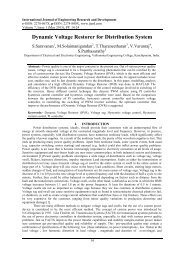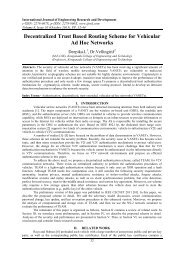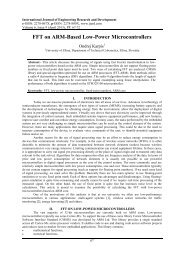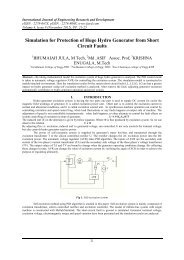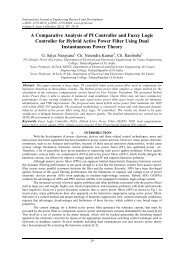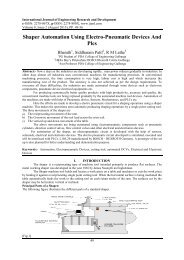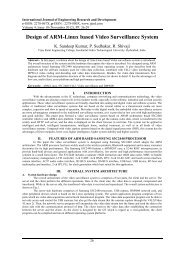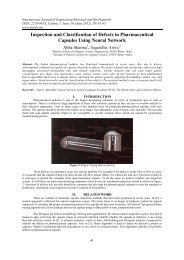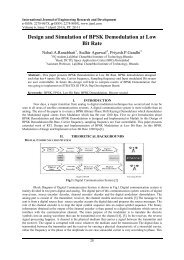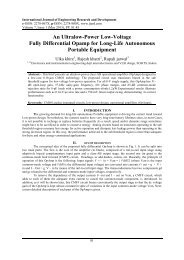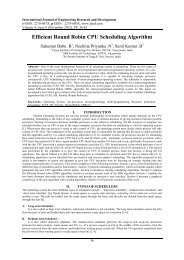growth of electrical discharge machining and its applications - IJERD
growth of electrical discharge machining and its applications - IJERD
growth of electrical discharge machining and its applications - IJERD
Create successful ePaper yourself
Turn your PDF publications into a flip-book with our unique Google optimized e-Paper software.
International Journal <strong>of</strong> Engineering Research <strong>and</strong> Development<br />
e-ISSN: 2278-067X, p-ISSN : 2278-800X, www.ijerd.com<br />
Volume 4, Issue 12 (November 2012), PP. 13-22<br />
Growth <strong>of</strong> Electrical Discharge Machining <strong>and</strong> Its<br />
Applications – A Review<br />
C. Bhaskar Reddy 1 G. Jayach<strong>and</strong>ra Reddy 2 , C. Eswara Reddy 3<br />
1 Research Scholar, Dept. <strong>of</strong> Mech. Engg, S.V. University College <strong>of</strong> Engg, Tirupati, A.P.<br />
2 Pr<strong>of</strong>. <strong>of</strong> Mech. Engg, Yogi Vemana University College <strong>of</strong> Engineering, Proddatur, A.P.<br />
3 Pr<strong>of</strong>. <strong>of</strong> Mech, Engg, & Director, S.P. Mahila University Engg. College, Tirupati, A.P.<br />
Abstract:-Globalization is making the manufacturers to invest <strong>and</strong> invent in the manufacture / production <strong>of</strong> sophisticated<br />
<strong>and</strong> quality products to meet ever changing needs <strong>of</strong> the customer. Thus, the research in manufacturing has been<br />
concentrated towards the high speed <strong>machining</strong> involving CNC Machines, Robots <strong>and</strong> Automated H<strong>and</strong>ling Systems with<br />
the emergence <strong>of</strong> computers in Engineering on one side <strong>and</strong> the development Unconventional Machining such as Chemical<br />
Machining, Laser Beam Machining (LBM), Electron Beam Machining (EBM) <strong>and</strong> Electron Discharge Machining (EDM) on<br />
the other side. Out <strong>of</strong> them, the environment <strong>of</strong> Chemical Machining is found to be hazardous, whereas LBM <strong>and</strong> EBM<br />
require huge investments in comparison to EDM. Therefore, the EDM is widely used in manufacturing. In the present paper,<br />
about 111 research papers are reviewed on the major topics <strong>of</strong> EDM research. It also reports on the research related to the<br />
adoptive monitoring <strong>and</strong> control <strong>of</strong> process <strong>and</strong> the feasibility <strong>of</strong> different strategies <strong>of</strong> obtaining the optimal <strong>machining</strong><br />
conditions. EDM as well as WEDM industrial <strong>applications</strong> are reported together with the hybrid <strong>machining</strong> process.<br />
Key Words:- EDM, WireEDM, Growth, Review, Modeling, Experiments.<br />
I. INTRODUCTON<br />
Electric Discharge Machining (EDM) is an Unconventional Machining technique <strong>of</strong> metal removal process<br />
consisting <strong>of</strong> erosion <strong>of</strong> material from the work piece due to series <strong>of</strong> discrete sparks between work piece <strong>and</strong> electrode<br />
separated by a thin film <strong>of</strong> dielectric fluid medium. The EDM process is generally divided into (i) Die-sinking EDM, (ii)<br />
Wire Electric Discharge Machining, (WEDM) (iii) MicroEDM, (iv) Powder Mixed EDM <strong>and</strong> (v) Dry EDM. What ever may<br />
be the type <strong>of</strong> process, the aim is to remove the metal from the work piece by optimum utilization <strong>of</strong> the <strong>machining</strong><br />
parameters to get the required shape with quality surface. In the optimum or better utilisation <strong>of</strong> the available <strong>machining</strong><br />
variable parameters through number <strong>of</strong> techniques either by experimentation or modeling are being used in the research <strong>and</strong><br />
in practice. The recent observation is being the application <strong>of</strong> the Wire-EDM in Granite Mining Operations to avoid the<br />
heavy manual involvement. The outline <strong>of</strong> various types <strong>of</strong> EDM <strong>and</strong> the techniques used for various materials are given in<br />
the Figure – 1. The technique starting from a simple means <strong>of</strong> making tools <strong>and</strong> dies has reached the stage as the best<br />
alternative <strong>of</strong> producing micro scale parts. Such EDM process <strong>growth</strong> is briefly discussed based on 111 contributions ever<br />
since <strong>its</strong> basic principle started with the erosive effect <strong>of</strong> electric <strong>discharge</strong>s.<br />
II.<br />
ELECTRIC DISCHARGE MACHINING (EDM)<br />
The Literature shows the basis <strong>of</strong> EDM with the discovery <strong>of</strong> the erosive effect <strong>of</strong> electric <strong>discharge</strong>s or sparks<br />
during the year 1770 by the English Chemist Joseph priestly [1]. However, the destructive nature <strong>of</strong> properties <strong>of</strong> <strong>electrical</strong><br />
<strong>discharge</strong>s has been exploited for constructive purpose in the year 1943 at Moscow University [2]. The development <strong>of</strong> the<br />
system by Lazarenko [2] has been utilized the resistance capacitance type <strong>of</strong> Power Supply for the widely used EDM in the<br />
year 1950 <strong>and</strong> it became a model for successive development in EDM [3]. At the same time, the work <strong>of</strong> three American<br />
employees became the basis for vacuum tube EDM machine <strong>and</strong> the electronic servo system has automatically provided the<br />
proper electrode-to-work piece spacing for sparking, without the electrode contact [4]. The manufacturing / production<br />
technology has taken a revolutionary change in 1980s with the advent <strong>of</strong> computers <strong>and</strong> made the conventional machines as<br />
Computer Numerical Control (CNC) machines including EDM so as to manufacture sophisticated <strong>and</strong> quality products with<br />
accuracy <strong>and</strong> better productivity. Since then, the CNC in EDM made the process automatic starting from inserting the<br />
electrodes in place <strong>of</strong> tool till obtaining the finished / polished cavity or cavities [5]. Such CNC-EDM has resulted in<br />
enormous benef<strong>its</strong> <strong>and</strong> influenced the research area. Thus, it is common in the research to bring-out the contributions <strong>of</strong><br />
various researchers / manufacturers / experts from time to time. In the process, the EDM operating <strong>and</strong> performance<br />
parameters along with electrode design <strong>and</strong> manufacture [6], Role <strong>of</strong> EDM in Unconventional <strong>and</strong> CNC <strong>machining</strong> [7] <strong>and</strong> a<br />
Review on EDM in relation to the Aluminum Matrix Composites [8] have been seen. The EDM is further exp<strong>and</strong>ed as<br />
WEDM. The influence <strong>of</strong> current, Voltage on MRR, surface roughness in WEDM [9] <strong>and</strong> <strong>its</strong> relevant topics with the<br />
relationship between the dynamics <strong>of</strong> electrode <strong>and</strong> control in WEDM [10] <strong>and</strong> <strong>applications</strong> <strong>of</strong> WEDM [11] have been<br />
briefly discussed. Then the trend <strong>of</strong> research in Die-sinking EDM on (i) Conductive Ceramics [12] <strong>and</strong> (ii) Silicon Carbide<br />
Metal Matrix Composites, {13] have been reviewed. All <strong>of</strong> them have given future direction on the topics: MRR, surface<br />
finish, wire diameter, Tool wear, Current rate, kerf, accuracy, etc. Out <strong>of</strong> the available EDM processes, the Wire EDM is<br />
found to be more flexible <strong>and</strong> hence the review is briefly brought in the following.<br />
13
Growth Of Electrical Discharge Machining And Its Applications – A Review<br />
III.<br />
DEVELOPMENTS IN EDM<br />
The research has gained importance in various angles in terms <strong>of</strong> experimental studies, modeling both<br />
mathematical <strong>and</strong> simulation <strong>and</strong> also other techniques for EDM with the main objective <strong>of</strong> either to maximise the metal<br />
removal rate (MRR) or minimise the <strong>machining</strong> time <strong>and</strong> tool wear or optimise the <strong>machining</strong> cost to obtain better surface<br />
finish with either conventional or composite or metal combinations. Though extensive theoretical <strong>and</strong> experimental studies<br />
on various aspects <strong>of</strong> EDM process such as the machine types, tooling, control circu<strong>its</strong>, selection <strong>of</strong> the process conditions<br />
<strong>and</strong> online machine control [14]; the complex nature <strong>of</strong> EDM process <strong>and</strong> effect <strong>of</strong> interacting process parameters make the<br />
process analysis quite difficult. Therefore, the Researchers worldwide are focusing attention on modeling <strong>and</strong> optimization<br />
<strong>of</strong> EDM <strong>and</strong> <strong>its</strong> related processes. In the present paper, experimental studies <strong>and</strong> Modeling <strong>of</strong> <strong>machining</strong> parameters on<br />
various aspects <strong>of</strong> EDMs are briefly studied <strong>and</strong> presented in the following.<br />
Figure- 1 : Different types, process parameters <strong>and</strong> Performance measures <strong>of</strong> EDM<br />
3.1 STUDIES ON EDM<br />
The contributions <strong>of</strong> researchers have been reviewed in terms <strong>of</strong> experimental studies on EDM for <strong>machining</strong><br />
different materials including composite materials. Since the metal removal rate is dependent on the type <strong>of</strong> electrode used,<br />
the powder metallurgy technique for fabricating composite electrode has been tried so as to reduce the crakes <strong>and</strong> wear<br />
resistance, [15]. The feasibility <strong>of</strong> fabricating micro holes in high nickel alloy using micro EDM has been shown, [16] <strong>and</strong><br />
14
Growth Of Electrical Discharge Machining And Its Applications – A Review<br />
the hole making on WC-Co based R-C circuit was experimented, [17]. The copper electrodes give higher MRR than the Al<br />
electrodes during <strong>machining</strong> <strong>of</strong> stainless steel <strong>and</strong> carbides since Al electrodes under-go more wear than copper electrode<br />
due to their lower melting point <strong>and</strong> specific thermal energy during EDM, [18]. The graphite electrode is being used during<br />
<strong>machining</strong> <strong>of</strong> Tungsten Carbide ceramics, [19]. The effect <strong>of</strong> ultrasonic vibration <strong>of</strong> the electrode was studied on surface<br />
integrity <strong>of</strong> Tungsten carbide,[20]. The experiments conducted with EDM for surface roughness reveal that smooth<br />
<strong>machining</strong> surface <strong>and</strong> sharp bottom surface <strong>of</strong> V groove with PCD tool,[21], theTiCN-20Ni-10TaC cermets results in lower<br />
surface roughness than that <strong>of</strong> other cermets[22]; The surface roughness increases with increase in current [12,23]; the US-<br />
EDM helps not only in surface finishing but also increase in MRR,[24]; <strong>and</strong> also found that the pulse on time factor is most<br />
influencing factor in production <strong>of</strong> quality surface <strong>and</strong> MRR,[25]. The influence <strong>of</strong> electrode material, flushing, electrode<br />
dimension, depth <strong>of</strong> cut <strong>and</strong> planetary motion on EDM performance (material removal rate, the electrode wear, accuracy <strong>and</strong><br />
texture) is discussed, Lonardo <strong>and</strong> Bruzzone, [26].<br />
The experiments with Rotary EDM are conducted on Al 2 O 3p 6061 Al Composite <strong>and</strong> found that the (i) MRR<br />
increases significantly to certain extent <strong>and</strong> then decline in non-linear pattern with increase in pulse on time <strong>and</strong> peak<br />
current. (ii) Surface roughness increases with increase in current <strong>and</strong> pulse duration. (iii) Addition <strong>of</strong> SiC in Al metal matrix<br />
composite reduces the <strong>electrical</strong> conductivity <strong>of</strong> work material <strong>and</strong> hence Al-10 % SiCp can be effectively machined using<br />
EDM, [8] . The Review Paper <strong>of</strong> relating to the research work on EDM reveals that the SiC reinforced MMC with sinking<br />
EDM <strong>and</strong> powder mixed EDM have the potential scope to enhance the capability <strong>of</strong> <strong>machining</strong> performance so as to obtain<br />
better output product under better working conditions <strong>and</strong> concluded that the research work on dry EDM <strong>and</strong> using water in<br />
EDM as dielecric fluid are the emerging areas followed by MMCs, [13]. The multi objective optimization model on<br />
surfaceness <strong>of</strong> UNS C34000 Brass in EDM helps to identify the Roughness parameters in EDM with <strong>of</strong>fline control <strong>of</strong><br />
correlated multiple surface quality characteristics, [27] .<br />
IV.<br />
WIRE ELECTRIC DISCHARGE MACHINING (WEDM)<br />
A simple WEDM process is shown in the Figure -2.<br />
Figure -2: Simple wire EDM process with spark gap details [9]<br />
V. MODELING AND OPTIMISATION<br />
It is essential to produce any product with good quality at low cost with the requirement <strong>of</strong> customer. To achieve<br />
this objective, the influence <strong>of</strong> various parameters the process parameters have been studied to get the best performance <strong>of</strong><br />
either EDM or WEDM processes by many researchers <strong>and</strong> reported briefly in the sub sections.<br />
(i) Mathematical Models<br />
The Mathematical models, the most useful <strong>and</strong> non-destructive modeling techniques are emerged with the <strong>growth</strong><br />
<strong>of</strong> the computer memory. The utilization such techniques in wire EDM is briefly mentioned in the following. To start with,<br />
the development <strong>of</strong> Mathematical models to obtain the surface finish [28,29] <strong>and</strong> eroding surface [30] based on the <strong>discharge</strong><br />
parameters. The Mathematical models are widely developed to (i) Calculate the minimum gap distance for the spark<br />
generation between the work piece <strong>and</strong> the electrode [31]; (ii) predict the responses based on constraints <strong>of</strong> optimization<br />
techniques [32]; (iii) correlate the interrelationship <strong>and</strong> find the best working conditions <strong>of</strong> various parameters (peak current,<br />
duty factor, wire tension <strong>and</strong> water pressure) during the <strong>machining</strong> <strong>of</strong> Iconel-601 to obtain the MRR, wear ratio <strong>and</strong><br />
surfaceness, [33]; (iv) establish the relationship between the performance measures <strong>of</strong> the process <strong>and</strong> <strong>its</strong> controllable<br />
parameters [34]; (v) study <strong>and</strong> determine the crack zone beyond the crater due to the thermal stresses exceeding the lim<strong>its</strong><br />
due to longer pulse duration, high power <strong>and</strong> plasma channel radius, [35 ]; (vi) study the influence <strong>of</strong> peak current <strong>and</strong> pulse<br />
on time on surface roughness problem solving <strong>and</strong> optimization <strong>of</strong> process parameters [36].<br />
(ii) Simulation:<br />
The Simulation is developed on Computer Systems <strong>and</strong> depend on the speed <strong>of</strong> the Computer System. The inverse<br />
problem <strong>of</strong> obtaining the appropriate tool electrode shape for achieving the desired final workpiece shape is presented for<br />
die-sinking EDM by reverse Simulation <strong>and</strong> it can also be used in forward simulation,[37].The thermal stresses estimated<br />
during the Numerical Simulation <strong>of</strong> WEDM with FEM exceeded the yield strength <strong>of</strong> the HSS work piece mostly in the<br />
15
Growth Of Electrical Discharge Machining And Its Applications – A Review<br />
extremely thin zone near the spark, [38]. The design <strong>and</strong> the obtaining <strong>of</strong> an experimental database, a preliminary analysis<br />
for the selection <strong>of</strong> process variables <strong>and</strong> the establishment <strong>of</strong> wire breakage indicators can be achieved by Simulation [39].<br />
(iii) Fuzzy Logic:<br />
The larger the Gray – Fuzzy reasoning grade the better the multiple process response thereby the electrode wear<br />
ratio decreases <strong>and</strong> MRR increases in WEDM Process, [40]. The Fuzzy Logic model developed is compared <strong>and</strong> analysed<br />
multi response the optimization parameters [41]. The reliable pulse rate in the adoptive control system [42] <strong>and</strong> thermal<br />
analysis with spark erosion in relation to tool / work materials [43] are determined with Fuzzy Logic modeling followed by<br />
the prediction <strong>of</strong> the cutting velocity with in the selected range <strong>of</strong> <strong>machining</strong> parameters for higher material removal rate <strong>and</strong><br />
better surface finish <strong>and</strong> found that the output results are in good correlation with that <strong>of</strong> experimental results, [44].<br />
(iv) Artificial Neural Networks (ANN)<br />
ANN models are being used in modeling <strong>of</strong> <strong>machining</strong> parameters either independently or combining with other<br />
algorithms. To cite: six neural network models, namely the LOGMLP, TANMLP, RBFN, the error TANMLP, the adaptive<br />
TANMLP, the adaptive RBFN, <strong>and</strong> the ANTIS <strong>and</strong> a neuro-fuzzy model for MRR in EDM <strong>and</strong> observed that the ANTIS<br />
model is more accurate than the other models, [45]. Thus, the ANN models are used to estimate (i) crater shapes <strong>and</strong> surface<br />
roughness, [46, 47] <strong>and</strong> with back propagation <strong>and</strong> Feed forward with Back propagation technique to predict MRR, [48] <strong>and</strong><br />
then it is proved that the BPN is reasonably more accurate than RBFN where as RBFN is faster in comparison to BPN while<br />
modeling the surface roughness [49]. The effect <strong>of</strong> the pulse on time on material removal rate is estimated in combination<br />
with Genetic Algorithm hybrid model [50] <strong>and</strong> then the to study radial basis function <strong>of</strong> Neural Net works in MRR [51].<br />
The optimum <strong>machining</strong> process parameters, such as the shape <strong>of</strong> the crater cavity, MRR <strong>and</strong> TWR (tool wear<br />
rate) are determined by the Intelligent Process Model with FEM <strong>and</strong> ANN [52]. The cutting speed <strong>and</strong> surface roughness <strong>of</strong><br />
Tungsten carbide cobalt composite are predicted S<strong>of</strong>t computing models, [53]. The computational speed <strong>and</strong> accuracy are<br />
improved on one side <strong>and</strong> MRR is estimated on other side during the EDM <strong>of</strong> AISI D 2 Steel by Neuro – Fuzzy Model [54].<br />
The ANN model with back propagation can predict the response parameters such as MRR, Ra <strong>and</strong> fractal dimensions very<br />
accurately while <strong>machining</strong> HSS <strong>of</strong> M 2 grade working with electrolyte copper tool, [55]. The surface roughness <strong>of</strong> AISI<br />
4340 steel is predicted in combination with factorial design. Then the relationship between the ANN models <strong>and</strong><br />
Mathematical regression analysis are estimated <strong>and</strong> then compared with the experimental values for their trueness, [56].<br />
(v) Response Surfaceness Methodology (RSM)<br />
The Response Surfaceness Methodology (RSM) is being a technique being used based the output parameters so as<br />
to check the quality <strong>of</strong> the surface obtained in wire EDM <strong>and</strong> other output parameters. It is established by RS that the (i)<br />
Peak current (C) <strong>and</strong> concentration (D) influence the maximum MRR <strong>and</strong> smooth SR in a Powder Mixed Electrical<br />
Discharge Machining (PMEDM) [57]; whereas the Weighted Principal Component (WPC) method can <strong>of</strong>fer significantly<br />
better overall quality than the multi-response signal to noise ratio (MRSN) method [58]; that the peak-on time <strong>and</strong> peak<br />
current significantly affect the MRR <strong>and</strong> OC during micro-hole <strong>machining</strong> <strong>of</strong> Ti-6Al-4V with tungsten carbide electrode <strong>and</strong><br />
the RSM based experimental data is used to develop the regression based mathematical models [59].<br />
(vi) Taguchi Technique:<br />
The literature reveals that the Taguchi technique is the most effective modeling tool to study the performance<br />
characteristics <strong>of</strong> either EDM or WEDM process <strong>and</strong> determine the effect <strong>of</strong> input variables <strong>and</strong> their levels. Some <strong>of</strong> the<br />
contributions by Taguchi Technique in Wire EDM are brought-out in the following to decide the (i) Ra <strong>and</strong> MRR by<br />
Parametric Optimization [60]; the number <strong>of</strong> experiments <strong>and</strong> Optimization <strong>of</strong> <strong>machining</strong> parameters in relation to work<br />
piece by orthogonal array method [61]; multi-response optimization by weighted principle component method [62]; Surface<br />
Removal Rate, cutting radius <strong>of</strong> workpiece on <strong>machining</strong> <strong>of</strong> Al 2 O 3 particle Alloy (6061); [63] (Chiang <strong>and</strong> Chang, 2006);<br />
precision <strong>and</strong> accuracy are by Taguchi Dynamic Experiments with Fuzzy Logic Analysis by 81.5 %, [64]; accuracy <strong>and</strong><br />
surface roughness by the measured responses <strong>of</strong> MRR on Incoloy 800 super alloy [65]; the quality design in kerfwidth for<br />
<strong>machining</strong> <strong>of</strong> Nickel based super alloy Nimonic C263, [66]. The study carried-out with Taguchi for the minimum number <strong>of</strong><br />
experiments on <strong>machining</strong> <strong>of</strong> Aluminum-24345 problem can be solved when compared to full factorial design <strong>and</strong> proved<br />
by experimental results to demonstrate that the <strong>machining</strong> model is suitable, [67]<br />
(vii) ANOVA<br />
It is common practice to use Analysis <strong>of</strong> Variance (ANOVA) to estimate the performance <strong>of</strong> any system based on<br />
the input parameters <strong>and</strong> it also used in wire EDM. The influence <strong>of</strong> wire-EDM <strong>machining</strong> parameters, (i.e., pulse-on time,<br />
pulse-<strong>of</strong>f time, pulse peak current <strong>and</strong> wire tension) is investigated <strong>and</strong> established that the surface roughness is affected by<br />
multifold regression analysis for MRR, [68]. Further, the EDMed DC53 die steel is very much influenced by Pulse-on time<br />
<strong>and</strong> Pulse-peak current [69]. The optimal solutions to find the MRR <strong>and</strong> SR are developed <strong>and</strong> established that the Gaussian<br />
Process Regression (GPR) models have the advantage over the regression models [70]. Further, the optimal process<br />
parameters, namely peak current affects EWR, SR, [12] where as the pulse-on, pulse-<strong>of</strong>f wire speed <strong>and</strong> wire tension for<br />
simultaneous optimization <strong>of</strong> cutting speed <strong>and</strong> dimensional lag are determined by Grey Relational Analysis, [71] followed<br />
by the variation <strong>of</strong> output responses with process parameters are mathematically modeled using Non-linear regression<br />
analysis method <strong>and</strong> then checked for correlation with the experimental results, [72].<br />
EXPERIMENTAL INVESTIGATIONS:<br />
The experimental investigations on Wire EDM are normally conducted by dividing the input variable into two<br />
types, namely <strong>electrical</strong> <strong>and</strong> non-<strong>electrical</strong> variables. The normally considered <strong>electrical</strong> input variables are Peak Voltage<br />
16
Growth Of Electrical Discharge Machining And Its Applications – A Review<br />
(V), Peak Current (C ), Pulse duration (T), Polarity (P), Pulse Interval (t), Pulse Wave (W), etc. The non-<strong>electrical</strong><br />
parameters are Dielectric Fluid, Electrode Material <strong>and</strong> Work piece material. After <strong>machining</strong>, the normal out-put<br />
parameters such as Material Removal Rate (MRR), Surface Roughness (Ra), Tool Wear Rate (TWR), Current Rate (CR),<br />
Overcut (OC) <strong>and</strong> Kerf Width (KW) either independently or <strong>of</strong> combinations <strong>of</strong> any <strong>of</strong> them are normally being obtained<br />
during the experimentation on WireEDM Process. In the process, wire EDM sparking frequency monitor has been<br />
developed to detect the thermal load for on-line control to prevent the wire from rupture by means <strong>of</strong> a multi-objective<br />
model. Then the relationship between the <strong>machining</strong> rate <strong>and</strong> surface finish under optimal machine conditions has been<br />
proved by experimental investigations,[73]. The experimental investigations are discussed in the following.<br />
5.1 Surface Roughness <strong>and</strong> MRR<br />
The surface roughness (Ra) <strong>and</strong> uniformity <strong>of</strong> the internal surfaces <strong>of</strong> the holes have been studied in a two stage<br />
Micro-EDM <strong>machining</strong> process consisting <strong>of</strong> fabrication <strong>of</strong> electrodes in first stage <strong>and</strong> by <strong>machining</strong> <strong>of</strong> holes in second<br />
stage, [74]. It is found in experimentation that the maximum cutting speed while <strong>machining</strong> with WEDM on the metal<br />
matrix composites <strong>of</strong> AlSi7Mg / SiC <strong>and</strong> AlSi7Mg / Al 2 O 3 is approximately 3 times <strong>and</strong> 6.5 times lower than the cutting<br />
speed <strong>of</strong> Aluminum alloy, respectively, [75] whereas better straightness, surface roughness, gap length, accuracy in corner<br />
cut <strong>and</strong> electrolytic corrosion-free obtained with the dry-WEDM over the conventional WEDM, [76]. It is also the wet dry<br />
wire EDM results in better surface integrity over dry wire EDM during <strong>machining</strong> on SUS304 Austenitic Stainless steel,<br />
[77]. The effects <strong>of</strong> electrolytic corrosion decreases as the AC the power source increases based on the <strong>electrical</strong> double layer<br />
theory <strong>and</strong> is proved by experimentation, [78]. The changing the pulse-on time, the cutting speed ( material removal rate),<br />
the surface roughness <strong>and</strong> the width <strong>of</strong> the slit <strong>of</strong> cutting significantly influence the volume fraction <strong>of</strong> reinforcement<br />
(Al 2 O 3 particles) in WEDM on Aluminum matrix composites (Al 2 O 3 p/ 6061 Al). It is also found that the frequent breakages<br />
<strong>of</strong> electrodes in <strong>machining</strong> metals with combination <strong>of</strong> SiC combinations <strong>and</strong> thus the usage <strong>of</strong> thin wires influence the<br />
surface wear at various settings <strong>of</strong> <strong>machining</strong> parameters WEDM, [79] followed by the effect <strong>of</strong> cutting parameters on the<br />
size <strong>of</strong> erosion, [80]. Therefore, new assisting electrode material is invented to avoid the breakages <strong>and</strong> established the<br />
WEDM method is also better suited for work pieces <strong>of</strong> Si 3 N 4 insulating ceramics [81]. Average surface finish in relation to<br />
wire wear [82], surface smoothness <strong>and</strong> cracks [83] are reported in the experimental studies.<br />
5.2 Machining <strong>of</strong> Steels:<br />
Experiments with wire EDM on reciprocating dry sliding pin on plate revealed that the Zro2-WC composite<br />
exhib<strong>its</strong> better tribological characteristics over Zro2-TiCN <strong>and</strong> Zro2-TiN, [84]. Further, the experimental results revealed<br />
that very low wire tension in <strong>machining</strong> <strong>of</strong> composites whereas a high flushing rate <strong>and</strong> a high wire speed were required to<br />
prevent wire breakage, [85].<br />
A new concept <strong>of</strong> specific <strong>discharge</strong> energy (SDE) is presented. It is observed that the materials having close<br />
values <strong>of</strong> SDE demonstrate very similar <strong>machining</strong> characteristics, if they are machined under the same <strong>machining</strong><br />
conditions, [86]. Therefore, the process performance is improved by silver coating on work piece material [87] <strong>and</strong> it is<br />
proved that the Zinc coated Brass Wire gives better performance than brass wire in terms <strong>of</strong> lower frequency <strong>of</strong> the breakage<br />
<strong>of</strong> wire, [88]. The hardness <strong>of</strong> material matrix will not affect whereas the recast layer on the Wire EDM surface has to be<br />
mechanically removed to improve the pipe-coupling efficiency <strong>and</strong> prevent the formation <strong>of</strong> the deformation cracks during<br />
expansion process, [89]. Tests have been conducted on various materials to study the effect <strong>of</strong> spark cycle <strong>and</strong> pulse on time<br />
<strong>of</strong> Wire EDM micr<strong>of</strong>eatures so as to underst<strong>and</strong> the root cause for the material fracture mechanism, [90]. An experimental<br />
study is carried out on WEDM to identify various significant control factors <strong>and</strong> their interactions that affect the <strong>machining</strong><br />
performance such as metal removal rate (MRR) <strong>and</strong> surface finish (SF) based on Taguchi Method. The relationship between<br />
control factors <strong>and</strong> responses like MRR & SF are established by means <strong>of</strong> non-linear regration analysis resulting in a valid<br />
mathematical model. Genetic algorithm is used to optimize the wire electric <strong>discharge</strong> <strong>machining</strong> process with multi<br />
objectives. The study demonstrated the wire EDM process parameters can be adjusted to achieve better MRR & SF<br />
simultaneously, [91]. A fine quality surface finish has been obtained on tool steel SKD11 by shortening the <strong>discharge</strong><br />
duration <strong>and</strong> lowering the peak current in the experimentation <strong>of</strong> WEDM using RC Pulse Generator, [92] . Reversed polarity<br />
<strong>machining</strong> with the appropriate pulse energy can improve the machined surface roughness, [93].<br />
Further, the analysis has been formulated using multiple regression method to study the effect <strong>of</strong> pulse-on time <strong>and</strong><br />
pulse-peak current, on the surface roughness. A model developed by [94] was validated by experimentation within 7%<br />
levels <strong>of</strong> error. An experimental determination method <strong>of</strong> the convective heat transfer coefficient in wire electro-<strong>discharge</strong><br />
<strong>machining</strong> (WEDM) is introduced. A special device is developed to measure the average temperature increment <strong>of</strong> the wire<br />
after a period <strong>of</strong> short circuit <strong>discharge</strong>s, <strong>and</strong> the thermal load imposed on the wire is also tracked <strong>and</strong> recorded. Then based<br />
on the thermal model <strong>of</strong> the wire, the convective coefficient is calculated accurately. The influence <strong>of</strong> the kerf <strong>and</strong> the effect<br />
<strong>of</strong> the coolant flushing pressure on the convective coefficient are studied [95]. In finish <strong>machining</strong> <strong>of</strong> wire -EDM, in order to<br />
study the surface morphology under various pulse duration, thermo-analysis is carried out to investigate the mechanism <strong>of</strong><br />
erosion <strong>of</strong> the work piece material using the finite element method. The results are verified with the experimentation <strong>and</strong><br />
observed that surfaces machined by short pulse duration <strong>and</strong> long pulse duration have similar roughness values when the<br />
pulse energies are almost the same. Also concluded that, during finish <strong>machining</strong> that has high requirements in surface<br />
roughness, long-duration pulses cannot meet the <strong>machining</strong> requirements <strong>and</strong> only short-duration pulses can be used to carry<br />
out the <strong>machining</strong>, [96]. It was observed that, the factor servo-voltage has the largest effect on all the response variables<br />
irrespective <strong>of</strong> the materials used in the experiments conducted on three materials (viz., Hot Die Steel, Oil Hardened Nonsinking<br />
Steel, <strong>and</strong> Mild Steel) to optimize the process parameters, [65] <strong>and</strong> also while <strong>machining</strong> AI / SiCp metal matrix<br />
composites using wire EDM [97]. Further, it is established that the surface finish <strong>of</strong> composite material is found to be<br />
better with increased % <strong>of</strong> SiC reinforcement.<br />
17
Growth Of Electrical Discharge Machining And Its Applications – A Review<br />
Experiments have been conducted to study the relationship between the MRR <strong>and</strong> Electrode Wear Ration (EWR)<br />
<strong>and</strong> surfaceness on an Alumina based ceramic composite, Al 2 O 3 / TiC / Si Cw <strong>and</strong> established that the (i) MRR increases<br />
with <strong>discharge</strong> current, pulse on time <strong>and</strong> duty cycle time, (ii) EWR increases with <strong>discharge</strong> current, duty cycle <strong>and</strong> gap<br />
Voltage <strong>and</strong> (iii) Surfaceness increases with an increase in <strong>discharge</strong> current <strong>and</strong> pulse on time, [98]. Experiments are<br />
conducted to drill high speed aspect ratio holes on microwave processed magnesium nano composites <strong>and</strong> established that<br />
the MRR <strong>and</strong> taper mainly depend on the servo speed <strong>and</strong> pulse on time, [99].<br />
5.3 Machining <strong>of</strong> Alloys:<br />
Electrode preparation techniques <strong>and</strong> the <strong>machining</strong> <strong>of</strong> micro holes are described in detail <strong>and</strong> showed that for<br />
brass electrodes, an arithmetic average roughness value as low as 1.7 μm is achieved. The technique <strong>of</strong> preparation in the<br />
usage <strong>of</strong> brass micro electrodes is found result in good quality surface <strong>and</strong> hence employed directly to machine the micro<br />
holes on the same machine using micro-EDM (μ-EDM) attachment, [100]. Further, the effect <strong>of</strong> <strong>discharge</strong> conditions on<br />
erosion efficiency have been studied in drilling with μ-WEDM using RC relaxation circuit in the melting <strong>and</strong> evaporation<br />
concept <strong>of</strong> material removal phenomenon,[101]. The tension <strong>of</strong> the micro wire electrode during the WEDM process is<br />
optimized in accordance with the <strong>discharge</strong> energy based on the coupled thermo-mechanical analysis, ( both the threedimensional<br />
temperature <strong>and</strong> the stress distribution), [102]. The usage <strong>of</strong> Copper based Graphite Electrodes is established<br />
that the (i) formation <strong>of</strong> microcracks at lower current range <strong>of</strong> 4 A <strong>and</strong> Pulse duration <strong>of</strong> 3.2 μs <strong>and</strong> (ii) produces crater with<br />
poor surface finish, with increases in high <strong>discharge</strong> current rate <strong>and</strong> longer pulse duration while <strong>machining</strong> AISI H13<br />
Steels [103]. To overcome such issues, a mathematical model <strong>of</strong> wire lateral vibration in <strong>machining</strong> is suggested to calculate<br />
the maximum amplitude <strong>of</strong> wire vibration [104]. The surface roughness increases with increase in current due to more metal<br />
removal in single <strong>discharge</strong> for a set <strong>of</strong> process parameters, [105]. With such background, the performance characteristics,<br />
such as material removal rate (MRR), tool wear rate (TWR) <strong>and</strong> over cut (OC) are studied <strong>and</strong> analysed the usage <strong>of</strong><br />
different dielectrics (kerosene <strong>and</strong> de-ionized water) in micro hole <strong>machining</strong> <strong>of</strong> Ti-6Al-4V, [106]. The de-ionized water is<br />
used in <strong>machining</strong> <strong>of</strong> two different materials in the experimental work to find the MRR <strong>and</strong> Ra, [107]. In doing so, the<br />
machined kerf width varies with different <strong>machining</strong> parameters, which greatly influences the <strong>machining</strong> precision. The<br />
higher the value <strong>of</strong> thermal conductivity <strong>and</strong> specific heat capacity <strong>of</strong> machined material decrease the efficiency have been<br />
established by the experiments on WEDM on materials – Titanium Alloys (Ti6A1-4V) <strong>and</strong> cemented Carbides (B40), [108].<br />
Based on the above observations, two thermal models namely, (i) the r<strong>and</strong>om pulse model for <strong>machining</strong> thin work pieces,<br />
<strong>and</strong> (ii) the clusters model for thicker work pieces are proposed. Further, a transient thermal analysis for the determination<br />
<strong>of</strong> temperature distribution in the wire <strong>of</strong> a WEDM process under multiple <strong>discharge</strong> condition is reported by using an<br />
explicit finite-difference method. The studies have revealed that the (a) thermal loads <strong>of</strong> wire EDM with short elapsed time is<br />
essential while <strong>machining</strong> thin work pieces <strong>and</strong> (b) where as the long elapsed time under multiple spark conditions will<br />
increase wire velocity <strong>and</strong> thus reduces the maximum temperature, [109]. Further, a better surface is obtained by micro<br />
electric <strong>discharge</strong> <strong>machining</strong> using powder mixed dielectric (PMD) media on SKH-51 tool steels while compared to<br />
Tungsten Carbide (WC) [110]. Recently, coatings have been introduced to increase the strength <strong>of</strong> the copper <strong>and</strong><br />
composite wires <strong>and</strong> established that the wires with α-phase, β-phase <strong>and</strong> γ-phase coatings have significantly increased the<br />
wire EDM productivity [111].<br />
VI.<br />
CONCLUSIONS<br />
The EDM is an unconventional material removal process <strong>and</strong> flexible enough to meet the diverse <strong>machining</strong><br />
requirements posed by the dem<strong>and</strong> in the global metal cutting industries. With emergence <strong>of</strong> computers, the EDM process<br />
has been widely brought under varoius methods. Among them, the wire EDM has become more popular. It has been<br />
commonly applied for the <strong>machining</strong> <strong>and</strong> micro<strong>machining</strong> <strong>of</strong> parts with intricate shapes <strong>and</strong> varying hardness requiring high<br />
pr<strong>of</strong>ile accuracy <strong>and</strong> tight dimensional tolerances. However, the main advantage <strong>of</strong> the process is the relatively low<br />
<strong>machining</strong> speed as compared to other conventional <strong>machining</strong> process due to <strong>its</strong> thermal <strong>machining</strong> technique. The ultimate<br />
goal <strong>of</strong> Wire EDM process is to achieve an accurate <strong>and</strong> efficient <strong>machining</strong> operation combined with quality with at most<br />
best <strong>machining</strong> performance by the various factors affecting the process <strong>and</strong> identifying the optimal <strong>machining</strong> condition<br />
from number <strong>of</strong> combinations. More than one hundred papers have been reviewed <strong>and</strong> the salient contributions are brought<br />
in the paper. Such contributions will help the researchers but also the manufacturers to cope with the growing production /<br />
manufacturing techniques in global manufacturing arena.<br />
REFERENCES<br />
[1]. Webzell, S., The first steps in to EDM in Machinery, 159, (4040) Findlay Publ. Ltd, Kent, p.41, November, 2001.<br />
[2]. Anonymous, History <strong>and</strong> Development in the techniques <strong>and</strong> practice <strong>of</strong> spark Erosion <strong>machining</strong>, Spar Catron<br />
Limited, Gloucester, UK, pp.6, 1965.<br />
[3]. Livsh<strong>its</strong>, A. L., Introduction in Electro-erosion Machining <strong>of</strong> Metals, Development <strong>of</strong> Scientific & Industrial<br />
Research, London, 1960.<br />
[4]. Jameson, E.C., Description <strong>and</strong> Development <strong>of</strong> EDM, Electrical Society <strong>of</strong> Manufacturing Engineers, Dearbern,<br />
Michigan, pp16, 2001<br />
[5]. Houman, L., Total EDM in Jameson (Ed), Electrical Discharge Machining: Tooling, Methods <strong>and</strong> Applications,<br />
SME, Dearborn, Michigan, PP-5-19. 1983.<br />
[6]. Ho, K.H., et al., State <strong>of</strong> art on EDM, International Jl. <strong>of</strong> Machine Tools & Manufacture 43, pp.1287-1300, 2003.<br />
[7]. Bhaskar Reddy,C., V.D. Reddy, G. J. Reddy <strong>and</strong> C. E. Reddy, Unconventional Mchining – Role <strong>of</strong> Electric<br />
Discharge Machining – A Review, Proc. <strong>of</strong> 4 th National Conf. on Emerging Trends in Mechanical Engg., (ETME<br />
18
Growth Of Electrical Discharge Machining And Its Applications – A Review<br />
– 2011), G.H. Patel College <strong>of</strong> Engineering & Technology, Vallabha Vidya Nagar, Gujarat, India, March, 18-19,<br />
2011.<br />
[8]. Balbir Singh, Sudhir Kumar <strong>and</strong> Jatindar Kumar, A Review <strong>of</strong> Eelctro Discharge Machining <strong>of</strong> Aluminum Metal<br />
Matrix Composites, Proc. <strong>of</strong> 3 rd International Conf. on Advances in Mechanical EngH., S.V. NIT, Surat, India, pp.<br />
993-997, Jan. 4-6, 2010.<br />
[9]. [9] Ho, K.H. et al., State <strong>of</strong> art in WEDM, International Journal <strong>of</strong> Machine Tools & Manufacture 44, pp.1247-<br />
1259, 2004.<br />
[10]. Altpeter, F. <strong>and</strong> Perez, R., Relevant topics in wire EDM control, Journal <strong>of</strong> material processing technology,<br />
Vol.149, pp.147-151, 2004.<br />
[11]. Bhaskar Reddy, C. et al., Evolution <strong>and</strong> Growth <strong>of</strong> WEDM <strong>and</strong> Applications – A Review, 2 nd AP Science<br />
Congress, S.V. University, Tirupati, Nov.14-16, 2009.<br />
[12]. Ms. Shruti Mehta et al, A Review on Current Research Trends in Die- Sinking Electrical Discharge Machining <strong>of</strong><br />
Conductive Ceramics, International Journal <strong>of</strong> Recent Trends in Engineering, Vol. 1, No. 5, May 2009,<br />
[13]. Kuldeep Ojha <strong>and</strong> Singh, K.K., Review <strong>and</strong> Future Trends <strong>of</strong> Sinking EDM <strong>and</strong> Silicon Carbide reinforced Metal<br />
Matrix Composites, Proc. <strong>of</strong> 3 rd International Conf. on Advances in Mechanical Engineering, S.V. National<br />
Institute <strong>of</strong> Technology, Surat, India, pp. 821-826, Jan. 4-6, 2010.<br />
[14]. Kunieda, M. etal. Advancing EDM through fundamental insight into the process, Annals <strong>of</strong> CIRP, 54, pp599-622,<br />
2005<br />
[15]. Simao, J. et al., Work piece surface modification using <strong>electrical</strong> <strong>discharge</strong> <strong>machining</strong>, Int. J. <strong>of</strong> Machine Tools &<br />
Manufacture 43 (2), pp. 121-128, 2003.<br />
[16]. Hung Sung Liu et al., A study on the characterization <strong>of</strong> high nickel alloy micro-holes using micro EDM <strong>and</strong> their<br />
<strong>applications</strong>, Journal <strong>of</strong> Materials Process Tech.,169, pp. 418-426, 2005.<br />
[17]. Hyun-Seok TAK, et al., Comparative study on <strong>discharge</strong> conditions in micro-hole <strong>electrical</strong> <strong>discharge</strong> <strong>machining</strong><br />
<strong>of</strong> Tungsten Carbide (WC-Co) material, Trans. Nonferrous Met. Soc. China 19, s114−s118, 2009.<br />
[18]. Ahsan Ali Khan <strong>and</strong> Safry Ezan Saifuddin, Wear characteristics <strong>of</strong> copper <strong>and</strong> Aluminum electrodes during EDM<br />
<strong>of</strong> stainless steel <strong>and</strong> carbide,ICME2005, Dhaka, Bangladesh, 28-30,Dce,2005.<br />
[19]. Mohd Amri Lajis ,et al The Implementation <strong>of</strong> Taguchi Method on EDM Process <strong>of</strong> Tungsten Carbide, European<br />
Journal <strong>of</strong> Scientific Research ISSN 1450-216X Vol.26 No.4, pp.609-617, 2009.<br />
[20]. Mohammad Reza Shabgard, Atanas Ivanov, Andrew Rees, Influence <strong>of</strong> EDM <strong>machining</strong> on surface integrity <strong>of</strong><br />
WC-Co, Manufacturing Engineering Centre, Cardiff University, 2006.<br />
[21]. Sadao Sano, et al., Hybrid Processing <strong>of</strong> EDM <strong>and</strong> grinding with an ED-T-formed PCD tool, ISAAT2007,<br />
Dearborn, Michigan, USA (2007).<br />
[22]. Manoj Kumar, B.V. et al., EDM performance <strong>of</strong> TiCN - based cermets, International Jl <strong>of</strong> Refractory Metals &<br />
Hard Materials 25, pp-293-299, 2007.<br />
[23]. Krishna Mohan Rao, G. et al., Influence <strong>of</strong> <strong>machining</strong> parameters on EDM <strong>of</strong> Mar aging Steels-An Experimental<br />
investigation, Proceedings <strong>of</strong> The World Congress on Engineering 2008, Vol II, London, U.K.July2-4, 2008.<br />
[24]. Shabgard, M.R. et.al, The effect <strong>of</strong> Ultrasonic Vibration <strong>of</strong> Work Piece in EDM <strong>of</strong> AISIH13 Tool Steel, World<br />
Academy <strong>of</strong> Science, Engg. & Tech. 52, 2009.<br />
[25]. Tomadi, S. H. et al., Analysis <strong>of</strong> influence <strong>of</strong> EDM Parameters on Surface Quality, MRR <strong>and</strong> Electrode Wear <strong>of</strong><br />
Tungsten Carbide, Proc. <strong>of</strong> International Conf. <strong>of</strong> Engineers & Computer Scientists 2009, V2, Hong Kong, 2009<br />
[26]. Lonardo. P.M <strong>and</strong> Bruzzone. A.A, Effect <strong>of</strong> Flushing <strong>and</strong> Electrode Material on Die Sinking EDM, Annals <strong>of</strong> the<br />
CIRP Vol. 48/1/1999.<br />
[27]. Datta, S., Ch<strong>and</strong>ra Routana, B., B<strong>and</strong>opadhyaya <strong>and</strong> Mahapathra, S.S., Proc. <strong>of</strong> 3rd International Conf. on<br />
Advances in Mechanical Engineering, S.V. National Institute <strong>of</strong> Technology, Surat, India, pp. 738-742, Jan. 4-6,<br />
2010.<br />
[28]. DiBitonto, D.D. et al., Theoretical models <strong>of</strong> EDM process.1. A simple cathode erosion model, Journal <strong>of</strong> Applied<br />
Physics, 66, pp. 4095-4103, 1989.<br />
[29]. Perez, R., et al. Theoretical modeling <strong>of</strong> energy balance in electro erosion, Journal <strong>of</strong> Material Processing<br />
Technology, 149, pp.198-203, 2004.<br />
[30]. Josko Valentincic. et al., A model for detection <strong>of</strong> the eroding surface based on <strong>discharge</strong> parameters, International<br />
Jl. <strong>of</strong> Machine Tools & Manuf. 44, pp-175-181, 2004.<br />
[31]. Yougshun Zhao et al, Geometric modeling <strong>of</strong> the linear motor driven EDM die sinking process, International Jl <strong>of</strong><br />
Machine Tools Manuf. 44, pp1-9, 2004.<br />
[32]. Sarkar, S. et al., Parametric analysis <strong>and</strong> optimization <strong>of</strong> wire <strong>electrical</strong> <strong>discharge</strong> <strong>machining</strong> <strong>of</strong> γ-titanium<br />
aluminide alloy, Journal <strong>of</strong> Materials Processing Technology, 159, pp.286-294, 2005.<br />
[33]. Hewidey, M.S., El-Taweel, T.A. <strong>and</strong> El-Safty, M.F., Modelling the Machining Parameters <strong>of</strong> Wire Electrical<br />
Discharge Machining <strong>of</strong> Inconel 601 using RSM, Journal <strong>of</strong> Materials Processing Tech, V. 169, pp. 328 – 336,<br />
2005.<br />
[34]. Taha Ali EI-Taweel., Parametric study <strong>and</strong> optimization <strong>of</strong> AL-Cu-TiC-Si P / M composite, International Journal<br />
<strong>of</strong> Machining <strong>and</strong> Mach inability <strong>of</strong> materials, 1(4), pp380-395, 2006.<br />
[35]. Deepak Kumar, P. <strong>and</strong> Rajat Kumar, B., Study <strong>of</strong> Surface Damage due to the Thermal Stresses in Electro<br />
Discharge Machining, Competitive Manufacturing, Proc. <strong>of</strong> 2 nd International & 23 rd AIMTDR Conf., IITMadras,<br />
Chennai, India, pp. 741 - 746, 2008.<br />
[36]. Shabgard, M.R. et al., Mathematical Modeling <strong>of</strong> Machining Parameters in Electrical Discharge <strong>machining</strong> <strong>of</strong><br />
FW4 Welded Steel, World Academy <strong>of</strong> science, Engineering <strong>and</strong> Technology 52, 2009.<br />
19
Growth Of Electrical Discharge Machining And Its Applications – A Review<br />
[37]. Masanori Kunieda, Wataru Kowaguchi <strong>and</strong> Takashi Takita, Reverse Simulation <strong>of</strong> Die-sinking EDM, Annals <strong>of</strong><br />
CIRP, Vol. 48 / 1/ 1999.<br />
[38]. Vinod Yadav, Vijay K. Jain <strong>and</strong> Prakash M. Dixit, Thermal Stresses due to Electrical Discharge Machining,<br />
Inter- national Journal <strong>of</strong> Machine Tools & Manufacture, 42, pp 877-888, 2002.<br />
[39]. Cabanes, J., Portillo. E., Marcos, M, <strong>and</strong> Sanche, J.A., An Industrial Application for online Detection <strong>of</strong> Instability<br />
<strong>and</strong> Wire Breakage in Wire EDM, Journal <strong>of</strong> Material Processing Technology, 195, pp. 101-109, 2008.<br />
[40]. Lin, J.L. <strong>and</strong> Lin, C.L., The use <strong>of</strong> Grey-Fuzzy Logic for the Optimisation <strong>of</strong> the Manufacturing Process, Journal<br />
<strong>of</strong> Materials Process Technology, Vol. 160, pp.9-14, 2005.<br />
[41]. Kuriakose, S. <strong>and</strong> Shunmugam, M.S., Multi objective optimization <strong>of</strong> wire EDM process by non- dominating<br />
sorting genetic algorithm, J. <strong>of</strong> Materials Processing Technology,170, pp.133-141, 2005.<br />
[42]. Oguzhan Yilmiz et al, Auser friendly fuzzy based system for the selection <strong>of</strong> EDM process parameters, Jl material<br />
Process. Tech.172, pp. 363-371, 2006.<br />
[43]. Yeo, S.H., et al. Critical assessment <strong>and</strong> numerical comparison <strong>of</strong> electro-thermal models in EDM, Jl. Mater.<br />
Process. Technol., 2007.<br />
[44]. Vijaya Bhaskara Reddy, P., Hemach<strong>and</strong>ra Reddy, K <strong>and</strong> Vikram Kumar, CH. R., Selection <strong>of</strong> Cutting Velocity<br />
in Wire-EDM Process using Fuzzy Logic, Proc. <strong>of</strong> the 2 nd International & 23 rd AIMTDR Conference, 2008.<br />
[45]. Kuo-Ming Tsai <strong>and</strong> Pei-Jen Wang, Comparisons <strong>of</strong> Neural Network Models on Material Removal Rate in<br />
Electrical Discharging Machining, Journal <strong>of</strong> Materials Processing Technology, 117, pp 111-124, 2001.<br />
[46]. Kuo-Ming Tsai <strong>and</strong> Pei-jen Wang, Predictions on surface finish in <strong>electrical</strong> <strong>discharge</strong> <strong>machining</strong> based upon<br />
neural network models, International Journal <strong>of</strong> machine tools <strong>and</strong> manufacture, 41, pp 1385-1403, 2001.<br />
[47]. Joshi, S.N. <strong>and</strong> P<strong>and</strong>e,S. S., Integrated process modeling <strong>of</strong> EDM using FEM <strong>and</strong> ANN, Proceedings <strong>of</strong> inter<br />
national Conference on Computer Aided Engineering, IIT Madras, Chennai, pp.552-559, December, 2007.<br />
[48]. P<strong>and</strong>a, D.K. <strong>and</strong> Bhogi, R.K., ANN prediction <strong>of</strong> material removal rate in EDM, Materials <strong>and</strong> Manufacturing<br />
process, 20, pp.645-672, 2005.<br />
[49]. Pradhan, M.K., Das, R. <strong>and</strong> Biswas, C.K., Comparisons <strong>of</strong> neural network models on surface roughness in<br />
<strong>electrical</strong> <strong>discharge</strong> <strong>machining</strong>, Journal <strong>of</strong> Engineering Manufacture Vol. 223 PP 801-808, 2009.<br />
[50]. Kesheng Wang et al., A hybrid intelligent method for modeling the EDM process, International Jl <strong>of</strong> Machine Tool<br />
Manuf. 43,995-999, 2003.<br />
[51]. M<strong>and</strong>al, D. et al., Modeling <strong>of</strong> EDM using BPNN <strong>and</strong> multi- objective optimization using non dominating sorting<br />
Algorithm-II, Journal <strong>of</strong> Material Processing Technology,186(1-3),154-162, 2007.<br />
[52]. Joshi, S.N. <strong>and</strong> P<strong>and</strong>e, S.S., 2008, Intelligent Process Modeling <strong>and</strong> Optimisation <strong>of</strong> EDM, Competitive<br />
Manufacturing, Proc. <strong>of</strong> 2 nd International & 23 rd AIMTDR Conf., IITMadras, Chennai, India, pp. 475 - 480, 2008.<br />
[53]. Probir Saha, et al., S<strong>of</strong>t computing models based prediction <strong>of</strong> cutting speed <strong>and</strong> surface roughness in wire EDM<br />
<strong>of</strong> Tungsten carbide cobalt composite, International Jl. <strong>of</strong> Advanced Manuf. technology, 39(1-2),pp.74-84, 2008.<br />
[54]. Mohan Kumar Pradhan <strong>and</strong> Biswas, C.K., Competitive Manufacturing, Proc. <strong>of</strong> 2 nd International & 23 rd AIMTDR<br />
Conf., IITMadras, Chennai, India, pp. 469 - 474, 2008.<br />
[55]. Amit Kumar Pal, Simul, B. <strong>and</strong> Laha Dipak, Competitive Manufacturing, Proc. <strong>of</strong> 2 nd Internatiobnal & 23 rd<br />
AIMTDR Conf., IITMadras, Chennai, India, pp. 481- 487, 2008.<br />
[56]. Esme.U, Sagbas. A, <strong>and</strong> Kahraman. F, Prediction <strong>of</strong> Surface Roughness in Wire Electrical Discharge Machining<br />
using Design <strong>of</strong> Experiments <strong>and</strong> Neural Networks, Iranian Journal <strong>of</strong> Science <strong>and</strong> Technology, Transaction-B,<br />
Engineering, Vol. 33, No. B3, pp 231-240, 2009.<br />
[57]. Kansal, H. K., Singh, S. <strong>and</strong> Kumar, P., Parametric Optimisation <strong>of</strong> Powder Mixed Electrical Discharge<br />
Machining by Response Surface Methodology, Journal <strong>of</strong> Materials Processing Technology, Vol. 169, pp. 427 –<br />
436, 2005.<br />
[58]. Gauri, S. K. <strong>and</strong> Chakraborty, S., Multi-Response Optimization for WEDM Process Applying Weighted Principal<br />
Component, Proc. <strong>of</strong> the 2 nd International & 23 rd AIMTDR Conference, 2008.<br />
[59]. Pradann. B.B, Kibia. G <strong>and</strong> Bhattacharyya. B., Modeling <strong>of</strong> Micro-EDM Process Parameters through Response<br />
Surface Methodology, Proc. <strong>of</strong> the 2 nd International & 23 rd AIMTDR Conference, 2008.<br />
[60]. Swarup S. Mahapatra <strong>and</strong> Amar Patnaik., Parametric Optimization <strong>of</strong> Wire electric <strong>discharge</strong> <strong>machining</strong> (WEDM)<br />
process using Taguchi Method, Journal <strong>of</strong> Brazil Society <strong>of</strong> Mech. Sci. & Engg, 28(4), pp.422-429, 2006.<br />
[61]. Ramakrishnan, R., Karunamoorthy, L., Multi response optimization <strong>of</strong> WEDM operations using robust design,<br />
International Journal <strong>of</strong> Advanced Manufacturing Technology, 29, pp.105-112, 2006.<br />
[62]. Liao, H.C., Mult–response optimization using weighted Principal component, International Journal <strong>of</strong> Advanced<br />
Manufacturing Technology,27, pp.720 -725, 2006.<br />
[63]. Chiang, Ko-Ta, <strong>and</strong> Chang, Fu, Optimisation <strong>of</strong> the WEDM process <strong>of</strong> particle re-inforced Material with multiple<br />
Performance Characteristics using Grey Relational Analysis, Journal <strong>of</strong> Materials Processing Technology, V. 180,<br />
pp. 96 – 101, 2006.<br />
[64]. [64] Tzeng, Yith <strong>and</strong> Chen, Fu, Multi Objective Optimisation <strong>of</strong> High Speed Electrical Discharge Machining<br />
Process using a Taguchi Fuzzy based Approach, Materials <strong>and</strong> Design, Vol, 28, pp. 1159 – 1168, 2007.<br />
[65]. Ravindra, H.V., et al. Optimization <strong>of</strong> parameters <strong>of</strong> WEDM using Taguchi’s Technique to achieve Good surface<br />
finish <strong>and</strong> better accuracy, Proc. <strong>of</strong> 2 nd International&23 rd AIMTDR Conf. IIT, Madras, Chennai, India, 2008.<br />
[66]. Niladri M<strong>and</strong>al, Saha, P., Ramesh Kumar, K., <strong>and</strong> Dr. Yadav., Study on Machining Parameters Optimization for<br />
WEDM <strong>of</strong> Nimonic C263 – A Taguchi Approach, Proc. Of the 3 rd International Conference on Advances in<br />
Mechanical Engineering, S V NIT, Surat, January 4-6, 2010.<br />
20
Growth Of Electrical Discharge Machining And Its Applications – A Review<br />
[67]. Srinivasa Rao, P., Ramji, K <strong>and</strong> Satyanarayana, B., Effect <strong>of</strong> WEDM Conditions on Surface Roughness : A<br />
parametric Optimisation using Taguchi Method, International Jl. <strong>of</strong> Advanced Engineering Sciences &<br />
Technologies, Vol. 6, No.1, pp. 041 – 048, 2011.<br />
[68]. Petropoulos, G., et al. Modeling <strong>of</strong> surface finish in electro - <strong>discharge</strong> <strong>machining</strong> based upon statistical multiparameter<br />
analysis, Journal <strong>of</strong> Material Processing Technology, 155-156, pp.1247-1251, 2004.<br />
[69]. Kalyanasri, K., <strong>and</strong> Boonmung,S., An Investigation on effects <strong>of</strong> wire EDM Machining parameters on Sutface<br />
Roughness <strong>of</strong> newly developed DC53 Die Steel, Jl .<strong>of</strong> Material Processing Technology, pp. 187-188, pp. 26-29,<br />
2007<br />
[70]. Yuan, J., Wang. K., Tao, Y. <strong>and</strong> Fang. M., Reliable Multi-objective Optimisation <strong>of</strong> High-speed WEDM Process<br />
based on Gaussian Process Regression, International Journal <strong>of</strong> Machine Tools <strong>and</strong> Manufacture, Vol. 48, pp. 47-<br />
60, 2008.<br />
[71]. Kamal Jangra, S<strong>and</strong>eep Groover, Ajai Jain <strong>and</strong> Aman Aggarwal, Optimization <strong>of</strong> Multiple Machining<br />
Characteristics in Die Cutting with WEDM using Grey Relational Analysis, Proc. Of the 3 rd International<br />
Conference on Advances in Mechanical Engineering, S V NIT, Surat, January 4-6, 2010.<br />
[72]. Muthu Kumar. V, Suresh Babu. A, Venkata Swamy. R <strong>and</strong> Raajenthiren. M, Optimization <strong>of</strong> the WEDM<br />
Parameters on Machining Incoloy800 Super Alloy with Multiple Quality Characteristics, International Journal <strong>of</strong><br />
Engineering Science <strong>and</strong> Technology, Vol. 2(6), pp 1538-1547, 2010.<br />
[73]. Rajurkar, K.P., <strong>and</strong> Wang, W.M,, Thermal Modeling <strong>and</strong> On-Line Monitoring <strong>of</strong> Wire-EDM, Journal <strong>of</strong><br />
Materials Processing Technology, 38, pp 417-430, 1993.<br />
[74]. Allen. D.M, Almond. H.J.A, Bhogal. J.S, Green. A.E, Logan. P.M <strong>and</strong> Huang. X.X, Typical Metrology <strong>of</strong> Micro-<br />
Hole Arrays Made in Stainless Steel Foils by Two-Stage Micro-EDM, Annals <strong>of</strong> the CIRP Vol.48/1/1999.<br />
[75]. Rozenek. M, Kozak. J, Dabrowski. L <strong>and</strong> Lubkowski. K, Electrical Discharge Machining Characteristics <strong>of</strong> Metal<br />
Matrix Composites, Journal <strong>of</strong> Materials Processing Technology, 109, pp 367-370, 2001.<br />
[76]. Masanori Kunieda <strong>and</strong> Chika Furudate, High Precision Finish Cutting by Dry WEDM, Annals <strong>of</strong> CIRP, V 50/1/<br />
2001.<br />
[77]. Abdulkareem, S., Khan, A.A. <strong>and</strong> Zain, Z.M., Effect <strong>of</strong> Machining parameters on Surface Roughness during Wet<br />
<strong>and</strong> Dry wire EDM <strong>of</strong> Stainless Steel, Journal <strong>of</strong> applied Sciences, 11 (10), pp. 1867 – 1871, 2011.<br />
[78]. Do Kwan Chung, H.S. Shin, Bo.H. Kim <strong>and</strong> Ch.N. Chu, High Frequency Micro Wire EDM for Electrolytic<br />
Corrosion Prevention, International Jl. <strong>of</strong> Precision Engineering <strong>and</strong> Manufacturing, Vol. 12, No.6, pp. 1125 –<br />
1128, 2011.<br />
[79]. Tosun, N. et al., The effect cutting parameters on wire crater sizes in wire EDM, International Jl <strong>of</strong> Advanced<br />
manuf. technology, Vol.21, pp.857-865, 2003.<br />
[80]. Tosun, N. <strong>and</strong> Cogun,C., An investigation on wire wear in WEDM, Journal <strong>of</strong> materials processing technology,<br />
Vol.134, pp. 273-278, 2003.<br />
[81]. Takayuki Tani, Yasushi Fukuzawa, Naotake Mohri, Nagao Saito <strong>and</strong> Masaaki Okada, Machining Phenomena in<br />
WEDM <strong>of</strong> Insulating Ceramics, , Journal <strong>of</strong> Materials Processing Technology, 149, pp 124-128, 2004.<br />
[82]. Takino, et.al., Cutting <strong>of</strong> Polished single crystal silicon by wire <strong>electrical</strong> <strong>discharge</strong> <strong>machining</strong>, Precision<br />
Engineering,Vol.28, pp.314-319, 2004.<br />
[83]. Kruth, J.P. et al., Composites wires with high tensile core for wire EDM, Annals <strong>of</strong> CIRP, V.53/1, PP-171-174,<br />
2004.<br />
[84]. Liao, Y.S., Study <strong>of</strong> Specific energy in WEDM <strong>and</strong> <strong>its</strong> application, International Journal <strong>of</strong> Machine Tools <strong>and</strong><br />
Manufacture, 44, pp.1373-380, 2004.<br />
[85]. Biing Hwa Yan, Hsien Chung Tsai, Fuang Yuan Huang <strong>and</strong> Long Chorng Lee, Examination <strong>of</strong> Wire Electrical<br />
Discharge Machining <strong>of</strong> Al 2 O 3 p/ 6061 Al Composites, International journal <strong>of</strong> Machine Tools & Manufacture, 45,<br />
pp 251-259, 2005.<br />
[86]. Liao, Y.S <strong>and</strong> Yu, Y.P., The Energy Aspect <strong>of</strong> Material Property in WEDM <strong>and</strong> <strong>its</strong> Application, Journal <strong>of</strong><br />
Materials Processing Technology, 149, pp 77-82, 2004.<br />
[87]. Jerzy Kozak, Kamlakar P. Rajurkar <strong>and</strong> Niraj Ch<strong>and</strong>arana, Machining <strong>of</strong> Low Electrical Conductive Materials by<br />
Wire Electrical Discharge Machining, Journal <strong>of</strong> Materials Processing Technology, 149, pp 266-271, 2004.<br />
[88]. Kumar, R. <strong>and</strong> Choudary, S.K., Prevention <strong>of</strong> wire breakage in Wire EDM, Inter-national Jl. <strong>of</strong> Machining <strong>and</strong><br />
Machinability <strong>of</strong> Materials, V. 9, no. ½, pp. 86-102, 2011<br />
[89]. Lin, H.C., Lin, K. M., Chen, Y.S. <strong>and</strong> Chu, C.L., The Wire Electro-<strong>discharge</strong> Machining Characteristics <strong>of</strong> Fe –<br />
30Mn-6Si <strong>and</strong> Fe-30Mn-6Si-5Cr Shape Memory Alloys, Jl <strong>of</strong> Material Processing Technology, Vol. 161, 435-439,<br />
2005.<br />
[90]. Miller, S.F., Chen-C, K <strong>and</strong> Albert, J. S. <strong>and</strong> Jun Qu, Investigation <strong>of</strong> Wire Electrical Discharge Machining <strong>of</strong><br />
Thin Cross Sections <strong>and</strong> Compliant Mechanisms,International Jl. <strong>of</strong> Machine tools&Manufacture,V45,pp1717–<br />
1725, 2005<br />
[91]. Mahapatra, S.S <strong>and</strong> Amar Patnaik, Optimization <strong>of</strong> Wire Electrical Discharge Machining (WEDM) Process<br />
Parameters using Genetic Algorithm, Indian journal <strong>of</strong> Engineering <strong>and</strong> Materials Science, 13, pp 494-502, 2006.<br />
[92]. Yan, Mu <strong>and</strong> Lai, Yi., Surface Quality Improvement <strong>of</strong> Wire EDM using a fine finish Powder Supply,<br />
International Jl. <strong>of</strong> Machine Tools <strong>and</strong> Manufacture, Vol. 47, pp.1686 – 1694, 2007.<br />
[93]. Fuzhu Han, Jun Jaing <strong>and</strong> Dingwen Yu, Influence <strong>of</strong> Machining Parameters on Surface Roughness in Finish Cut<br />
<strong>of</strong> WEDM, International journal <strong>of</strong> advanced manufacturing technology, 34, pp 538-546, 2007.<br />
[94]. Kalyanasiri, K. <strong>and</strong> Boonmung, S., Effects <strong>of</strong> wire-EDM <strong>machining</strong> variables on surface roughness <strong>of</strong> newly<br />
developed DC 53 Die Steel: Design <strong>of</strong> experiments <strong>and</strong> regression model, Jl. <strong>of</strong> Materials Processing Technology,<br />
192-193, pp 459-464, 2007.<br />
21
Growth Of Electrical Discharge Machining And Its Applications – A Review<br />
[95]. Gang Cheng, Fuzhu Han, <strong>and</strong> Zhijing Feng, Experimental Determination <strong>of</strong> Convective Heat Transfer Coefficient<br />
in WEDM, International journal <strong>of</strong> Machine Tools & Manufacture, 47, pp 1744-1751, 2007.<br />
[96]. Fhuzu Han, Jun Jiang <strong>and</strong> Dingwen Yu, Influence <strong>of</strong> Discharge Current on Machined Surfaces by Thermo-analysis<br />
in finish cut <strong>of</strong> WEDM, International journal <strong>of</strong> Machine Tools & Manufacture, 47, pp 1187-1196, 2007.<br />
[97]. Patil, N.G. <strong>and</strong> Brahmankar, P.K., Some Investigations onto Surface Characteristics <strong>of</strong> Wire Electro Discharge<br />
Machined Metal Matrix Composites, Proc. <strong>of</strong> the 2 nd International & 23 rd AIMTDR conference, 2008.<br />
[98]. Patel, K., P<strong>and</strong>e, P.M. <strong>and</strong> Rao, P.V., Experimental Investigations to study EDM Machinability <strong>of</strong> TiC particle<br />
<strong>and</strong> SiC Whisker Reinforced Al 2 O 3, Ceramic Composite, Competitive Manufacturing, Proc. <strong>of</strong> 2 nd Internatiobnal<br />
& 23 rd AIMTDR Conf., IITMadras, Chennai, India, pp. 719- 724, 2008.<br />
[99]. Ponappa, K., Aravindan, S., Rao, P.V. & Gupta, M., Competitive Manufacturing, Proc. <strong>of</strong> 2 nd International & 23 rd<br />
AIMTDR Conf. IITMadras, Chennai, India,pp.665-670, 2008<br />
[100]. Somashekhar. K.P <strong>and</strong> Jose Mathew, Fabrication <strong>of</strong> Microelectrodes for Micro EDM Operation Using Micro<br />
WEDG, Proc. <strong>of</strong> the 2 nd International & 23 rd AIMTDR conference, 2008.<br />
[101]. Somashekhar. K.P, Subba Rao Nuvvula <strong>and</strong> Jose Mathew, Effect <strong>of</strong> Discharge Conditions on the Performance <strong>of</strong><br />
Micro Electrical Discharge Machining, Proc. <strong>of</strong> the 2 nd International & 23 rd AIMTDR Conference, 2008.<br />
[102]. Fuzhu Han, Gang Cheng, Zhijing Feng <strong>and</strong> Soichiro Isago, Thermo-mechanical Analysis <strong>and</strong> Optimal Tension<br />
Control <strong>of</strong> Micro Wire Electrode, International journal <strong>of</strong> Machine Tools & Manufacture, 48, pp 922-931, 2008.<br />
[103]. Radhakrishnan, P. <strong>and</strong> Gowri, S., Study on Surface Integrity <strong>of</strong> AISI H-13 (improved) in Electrical Discharging<br />
Machining, Competitive Manufacturing, Proc. <strong>of</strong> 2 nd International & 23 rd AIMTDR Conf., IITMadras, Chennai,<br />
India, pp. 753 - 758, 2008.<br />
[104]. Di Shichun, Chu Xuyang, Wei Dongbo, Wang Zhenlong, Chi Guanxin <strong>and</strong> Liu Yuan, Analysis <strong>of</strong> Kerf width in<br />
Micro-WEDM, International journal <strong>of</strong> Machine Tools & Manufacture, 49, pp 788-792, 2009.<br />
[105]. Gulamali R. Khunt, et al., An Experimental Study on WEDM <strong>of</strong> Aluminum Wrought Alloy AA 6351 With a<br />
Novel Dielectric Fluid, National Conference On Lean Manufacturing Implementations: LEMAN 2009.<br />
[106]. Kibia. G, Pradann. B.B, Sarkar. B.R <strong>and</strong> Bhattacharyya. B., Influence <strong>of</strong> Different Dielectrics on Micro-EDM<br />
characteristics during Machining <strong>of</strong> Ti-6Al-4V, Proc. <strong>of</strong> the 2 nd International & 23 rd AIMTDR Conference, 2008.<br />
[107]. Bhaskar Reddy, C., Diwakar Reddy, V. <strong>and</strong> Eswara Reddy, C., Experimental investigations on MRR <strong>and</strong> Surface<br />
Roughness <strong>of</strong> EN19 <strong>and</strong> SS420 Steels in Wirw-EDM using Taguchi Method, International Journal <strong>of</strong> Engineering<br />
Science <strong>and</strong> Technology, Nov. 2012 (Under Review).<br />
[108]. Poros, D. <strong>and</strong> Zaborski, S., Semi-emperical Model <strong>of</strong> Efficiency <strong>of</strong> Wire Electrical Discharge Machining <strong>of</strong> Hardto-machine<br />
Materials, Journal <strong>of</strong> Materials Research Technology, Vol. 209, pp. 1247 – 1253, 2009.<br />
[109]. Simul Banerjee <strong>and</strong> Prasad, B.V.S.S.S., Numerical evaluation <strong>of</strong> transient thermal loads on a WEDM wire<br />
electrode under spatially r<strong>and</strong>om multiple <strong>discharge</strong> conditions with <strong>and</strong> without clustering <strong>of</strong> sparks, International<br />
Journal <strong>of</strong> Advanced Manufacturing Technology, 48, pp 571-580, 2010.<br />
[110]. Jahan, M.P., Anwar, M.M., Wong, Y.S. <strong>and</strong> Rahman, M., Nano finishing <strong>of</strong> Hard Materials using Micro Electro<br />
Discharge Machining, Proc. <strong>of</strong> International Mechanical Engg., Part – B: Journal <strong>of</strong> Engineering Manufacture,<br />
Vol. 223, pp. 1127 -1140, 2010.<br />
[111]. Jatinder Kapoor, Dr. Sehijpal Singh <strong>and</strong> Dr. Jaimal Singh Khamba, Recent developments in Wire Electrodes for<br />
High Performance WEDM, WCE 2010, June 30 – July2, 2010, London, U.K.<br />
22



